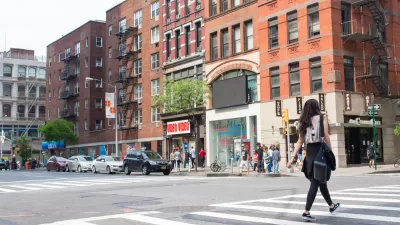Researchers find that among the largest 100 metro regions in the U.S. , those with a larger middle class, provide higher economic mobility.
Researchers who worked on a study that some cities seem to create opportunities for upward economic mobility also discovered some interesting correlations. Higher economic mobility was related to the size of the city's middle class.
"Does the middle class get bigger because economic mobility allows previously poor people to join those ranks? Or do poor people have higher economic mobility because a broad middle class drives opportunity for everyone? A large middle class, for instance, might support a stronger school system, which in turn benefits the lower-income students who attend it. This study can't answer this key causal question."
FULL STORY: Why the Size of Your City's Middle Class Matters Even if You're Not In It

Planetizen Federal Action Tracker
A weekly monitor of how Trump’s orders and actions are impacting planners and planning in America.

Map: Where Senate Republicans Want to Sell Your Public Lands
For public land advocates, the Senate Republicans’ proposal to sell millions of acres of public land in the West is “the biggest fight of their careers.”

Restaurant Patios Were a Pandemic Win — Why Were They so Hard to Keep?
Social distancing requirements and changes in travel patterns prompted cities to pilot new uses for street and sidewalk space. Then it got complicated.

DC Area County Eliminates Bus Fares
Montgomery County joins a growing trend of making transit free.

Platform Pilsner: Vancouver Transit Agency Releases... a Beer?
TransLink will receive a portion of every sale of the four-pack.

Toronto Weighs Cheaper Transit, Parking Hikes for Major Events
Special event rates would take effect during large festivals, sports games and concerts to ‘discourage driving, manage congestion and free up space for transit.”
Urban Design for Planners 1: Software Tools
This six-course series explores essential urban design concepts using open source software and equips planners with the tools they need to participate fully in the urban design process.
Planning for Universal Design
Learn the tools for implementing Universal Design in planning regulations.
Heyer Gruel & Associates PA
JM Goldson LLC
Custer County Colorado
City of Camden Redevelopment Agency
City of Astoria
Transportation Research & Education Center (TREC) at Portland State University
Camden Redevelopment Agency
City of Claremont
Municipality of Princeton (NJ)





























